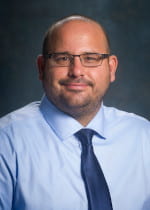 by Christina Crowe
by Christina Crowe
Sixto Leal, Jr., M.D., Ph.D., Associate Professor, Laboratory Medicine, UAB Pathology, has been awarded a 4-year, $2.97 million R01 grant from the National Institute of Allergy and Infectious Diseases to study secondary mold infections in patients with severe viral infections, such as COVID. These mold infections, if not recognized or treated, can be fatal. The grant, titled, “The Impact of SARS-CoV-2 Immune Dysregulation on Antifungal Immunity,” runs through July 2027.
“A subset of people with severe viral infections, including COVID, develop secondary mold infections,” Leal explains. “With this study, we aim to determine what predisposes otherwise healthy individuals to this infection, in order to optimize its diagnosis, prevention, and treatment.”
Leal explains that worldwide approximately 5-10% of patients with severe COVID develop an invasive Aspergillus (common mold) lung infection, usually around three weeks after the initial viral infection. The course can vary, but if it’s not diagnosed and treated, over half of affected individuals die from the smoldering fungal infection.
“The individual has a viral infection and is in the intensive care unit, when all of a sudden their oxygen requirements and chest x-rays get worse, and they rapidly deteriorate and die.” he says.
While treatment for the Aspergillus infection exists in the form of antifungal agents, the tricky part, Leal points out, is diagnosis of this secondary infection, “because the person already has respiratory issues—it’s easy to mistakenly attribute worsening disease to the virus, rather than the secondary mold infection.”
Leal and Peter Pappas, M.D., Professor, Division of Infectious Diseases, UAB Department of Medicine, and the Mycoses Study Group (MSG) recently completed a one-year, multi-center clinical trial funded by the Centers for Disease Control and Astellas Pharma, looking at the incidence of COVID-associated pulmonary aspergillosis (CAPA), and found that 5 percent of patients in the US hospitalized with severe COVID developed Aspergillus lung infection. “Despite this high incidence, it is not clear how viral infection renders an otherwise healthy host susceptible to mold infection”, Leal says.
“Our hypothesis is that the virus lyses host lung cells via specific programmed cell death mechanisms that can be targeted pharmacologically to block lung damage. Once the host cells die, they release a lot of factors, like iron, that are now available to support the growth of other microbes.”
For fungi, Leal says, "Iron is a major limiting factor during infection. Even small increases result in a significant growth advantage and our research shows that the lower airways of patients with severe COVID are iron-rich relative to iron poor non-viral respiratory infections.”
Leal and his research team will evaluate tissues from patients with severe COVID utilizing single cell spatial transcriptomics. Early access to this technology is due in part to Leal’s role as scientific director of UAB’s regional biocontainment facility, the Southeastern Biosafety Laboratory Alabama Birmingham, SEBLAB and recent NIH investment in this facility which enabled the purchase of the NanoString CosMx spatial imaging system. His team will also utilize a novel experimental human lung cell model and mouse model to dissect the mechanisms mediating secondary mold infection.
Leal says, “The translational implications of this work are particularly exciting as pharmacologic approaches to chelate excess airway iron or block viral-mediated lytic host cell death may enable targeted prophylaxis to prevent secondary infection in patients hospitalized with severe viral respiratory illness.”